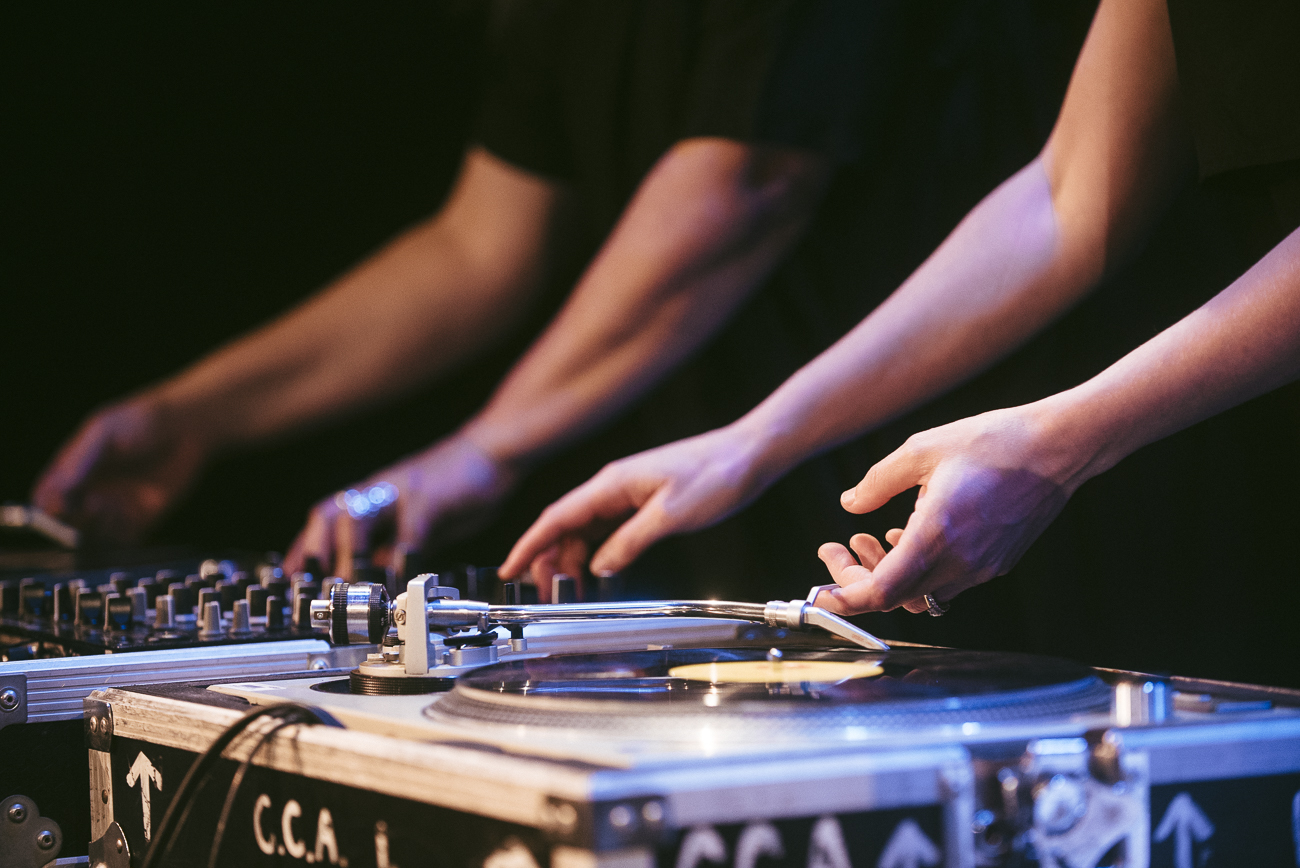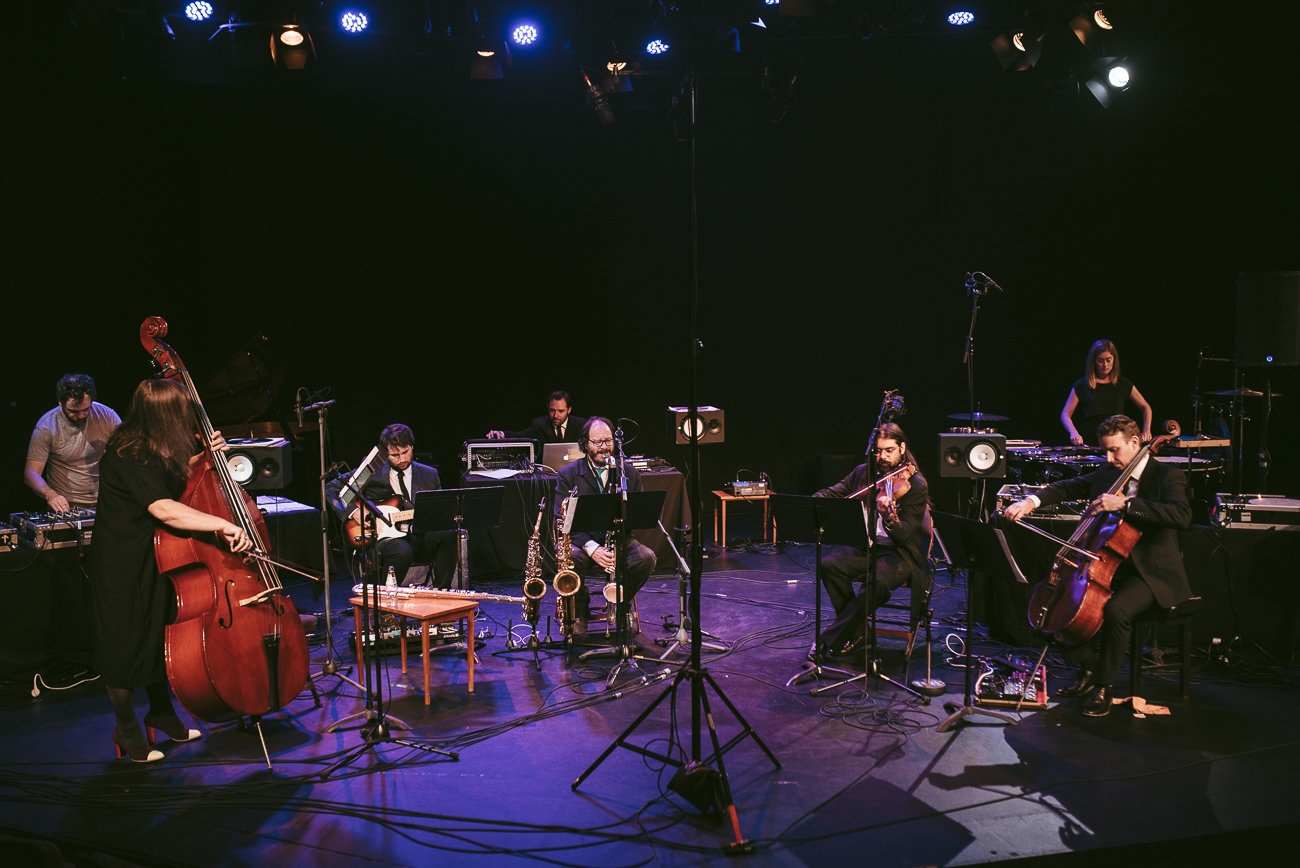The Decibel ensemble is devoted to using amplification, recording and playback devices (speakers, tape, computers) for the performance of new music, setting such sonic elements alongside live acoustic instruments such as flute, percussion, strings, clarinet and saxophone. Each of the pieces in Revolution: A Concert Dedicated To The Vinyl Record incorporated elements from a vinyl record, be this through the use of turntables, the playing of sounds sourced from vinyl, or in one instance broken vinyl records being incorporated into the score itself. The concert was in a sense a companion to Decibel’s 2009 premiere with Tape It, which featured analogue tape materials. Sampling of one kind or another provided a common – but not universal – feature within the program of Revolution, as well as there often being a sense of ghosting or haunting of musics leaking from the past into the present, and of the repetitive, cyclical locked groove of which vinyl is comprised.
 Revolution by Decibel. Photo supplied
Revolution by Decibel. Photo supplied
The program overall was however notable for the relative scarcity of hip-hop or contemporary avant-garde turntablism itself such as is produced by the likes of DJ Spooky or Christian Marclay. This decision may have been made because such forms are fairly well known within popular culture. Decibel’s own focus is in fact on the ensemble, and hence on how materials sourced in one way or another from (but not necessarily played back off) vinyl can complement or extend these live instrumental groupings.
Two works within Revolution’s eight piece program served as sonic reference points for the larger program. John Cage’s Imaginary Landscapes No. 5 is an instruction piece for the use of sampled materials, here performed live using turntables rather than via the playback of the prepared tapes which Cage himself employed. With an adroit and amusing collection of quoted records sourced by Rob Muir, the performance emphasised the rapid juxtaposition of a very diverse selection of unlike samples, much as in Cage’s landmark Williams Mix of 1952. Interruption and fragmentation was the order of the day. It was therefore something of a cultural tour, a haunted radiophonic journey through popular culture and recording history. Cage famously described theatre as “something which engages both the eye and the ear” and there was considerable drama in watching this group of performers frantically and carefully sifting through records. As in postmodern dance, the close attention to relatively straightforward tasks produced a wonderful drama of furrowed brows and focussed, small gestures.
Ryan Ross Smith’s Study No. 58 by contrast began with a minimal formalist exploration of those sounds specific to the turntable, namely the needle-drop, the scratch or blur, the jumping of the groove, and the crackles and clicks which come with such techniques. This provided a useful guide and reminder when listening to the other pieces to enable one to “spot the turntable sound” amongst a mixed palette. Smith’s work was however otherwise rather structurally flat, offering essentially a kind of slow shuffle through possibilities, each of which was then repeated for some time. Only towards the end did this expand out into a more satisfyingly dense bed of shifting crackly, squelchy sounds. Intriguing and measured though it was, Study No. 58 does not reach the level of such masterpieces of the crackly locked groove such as Michael Graeve has produced.
Elsewhere, the attention to the actual sounds of vinyl records themselves was more varied and in many instances rather indirect. Annika Moses for example offered a beautiful study for pre-recorded audio and live tenor saxophone entitled V.K.W 96.1 FM. The recorded material was sourced from old vinyl and tapes of Moses’ grandfather’s deliciously non-professional and digressive work as a radio announcer for community radio on the Cocos Keeling Islands. Scrabbling, thunky sounds and aged jazz snippets were answered by sharp saxophone retorts and breathy pops played by Lindsay Vickery. The highly conversational radio announcements themselves were translated into incomprehensible slurring text which Vickery pronounced into his saxophone. As with Cage, the piece was given to jumps and leaps, but on the whole, it had a laidback, dryly comedic theatricality. It would fit very well with the German muziktheater of the 1960s and 1970s.
 Revolution by Decibel. Photo supplied
Revolution by Decibel. Photo supplied
The opening piece by Milan Knížák was even further removed from the turntable as a live-instrument since it is one of a suite which Knížák composed using shards of vinyl pasted onto scores (Knížák also released a number of actual turntable recordings). It was a beautiful, delicate piece, with slow descents and rises in the strings accompanied by lilting flute motifs as well as pre-recorded electronic static.
In this focus on the ensemble itself – rather than turntablism proper – the compositions from Decibel founding members Cat Hope and Vickery were particularly masterful. Hope’s U Mangibeddu Nostru was inspired by an old recording of the tarantella on piano accordion, ghostly echoes of which intermittently drifted up from the background. This sense of uncanny emergence was central to the conceptual inspiration of the work, since Hope had been researching the fabled mad dances allegedly caused by spider bites (hence the name of the tarantella, its choreography supposedly being as wild and uncontrolled as the manic dances of those bitten by Italian tarantulas). The sounds of the recording were also evoked by flattened harmonica chords, sounded out by the ensemble to point us the way towards these older musical origins. Much of the rest of the material consisted of layered drones, with the violin and viola especially tending to slowly rise and fall during extended bowing. Brass chimes and rapid-fire, arrhythmic, dry percussion punctuated these drones, before harsh, string-bending electric guitar notes leapt out. In some ways the guitar provided the main structural guide within these gently rolling and roiling materials, harsh strikes giving way to constant rapid thrumming and then gentle mellifluous strums.
Vickery’s Agitation Techniques in a Closed System by contrast used the regular clicking in and out of the unholy buzz of an ungrounded circuit (akin to the sound a poorly installed turntable makes) to produce an edgy, dirging composition which intermittently broke into looping string and guitar flourishes. The piece also featured distorted fragments of recordings from new music works (Stockhausen, Scriabin, etc.). The structure was one of repeated and translated phrases which were suddenly broken off or spliced, with key musical motifs like the pulse or the snare-drum marking out these moments of collision and change. The live performers looped increasingly long phrases, and the ensemble came to recall a compressed, cut-up orchestra. The whole thing had a beautifully unsettled, agile feel which was regularly corralled into regularly pulsing materials by the sound of the ungrounded circuit.
The program was closed off by Decibel covering the Velvet Underground’s The Gift. They offered a wonderfully light, funky take on this fuzz guitar classic, which was accompanied by John Cale reading the short story featured in one speaker only of the original stereo recording. The concert thus ended in a rocking fashion, and like the title of this song, the program overall was quite a gift for audiences. One can only hope that Decibel will commit this program to vinyl themselves in the future.











Comments
Log in to join the conversation.